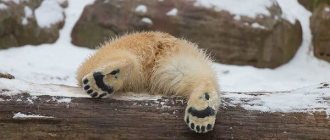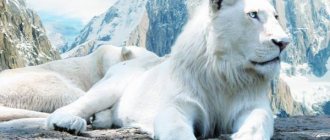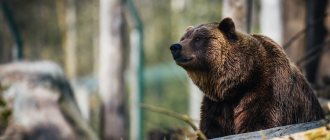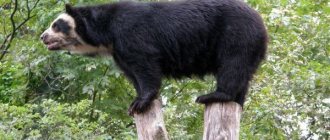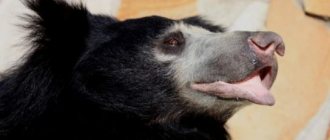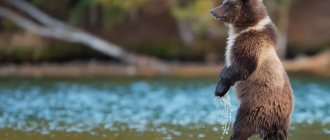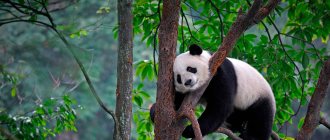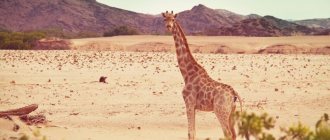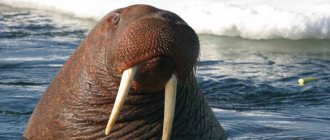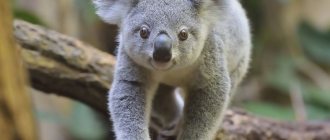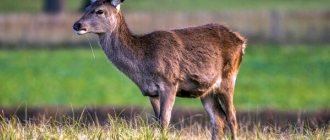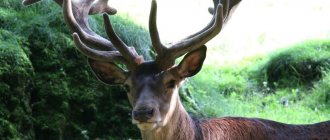Polar bears (lat. Ursus maritimus) are carnivorous mammals from the bear family. According to the original version, the species originated from brown bears about 150 thousand years ago. Information about the polar bear obtained as a result of recent research indicates that the species separated and formed 700-800 thousand years ago, but later, as a result of interspecific crossing, a hybrid of a polar and brown bear appeared. It is he who is the ancestor of modern polar bears.
Classification
Despite the genetic similarity of brown and polar bears, according to all evaluation criteria, they belong to different taxa. Various ecological niches, morphological characters, food preferences and behavioral characteristics made it possible to classify them into two independent species in the taxonomy.
Some confusion arose with the classification of the animal. Initially it was considered a land mammal. When it was established that there were membranes between the predator’s fingers, and that it spent a significant part of its time in the water, it was classified as a marine animal.
An amazing story of friendship
Few people would risk coming face to face with a polar bear. After all, these predators inspire fear with their colossal size and menacing appearance, forcing you to stay as far away from them as possible. But one resident of Canada is sure that these are surprisingly kind and sweet creatures, and below you can see evidence that a tender and touching friendship is possible between a person and a polar bear.
Man and bear are very comfortable in each other's company
Meet Mark Dumas, who lives in the city of Abbotsford, which is part of the Canadian district of British Columbia. And in his house lives a one-of-a-kind pet - a huge polar bear named Eiji. It is worth noting that Mark is a professional polar bear trainer; he has devoted more than 40 years to studying their habits and preparing animals for filming in feature films, documentaries and commercials.
With proper upbringing, even a polar bear will be as affectionate as a kitten.
This amazing story began 23 years ago, when Mark and his wife sheltered an orphaned polar bear cub and decided to keep him, that is, her, in their home. The couple bottle-fed the baby, after which they began to teach her good manners. As Mark himself admits, the hardest thing was to wean Eiji from biting, because this is the habit that is characteristic of all young bear cubs.
Mark with his little pet 23 years ago
But it was not in vain that Mark spent so many years in the company of polar bears, because he was able to thoroughly study their habits and character traits. According to the trainer, he always knows what Eiji’s mood is and what safety rules must be followed when communicating with his snow-white pupil.
Deadly number: Mark's head in Agee's mouth
Mr. Dumas and Agee constantly play, “wrestle,” and enjoy swimming in the pool. In general, the man and the bear are having fun and cannot imagine their existence without each other.
Guess who won the swim?
Agee not only loves Mark, the bear also has sincere, warm feelings for his wife Dawn. Which is not surprising, since his faithful wife helped Mark take care of the baby, taking an active part in her upbringing. Agee has been living with the Dumas family for 23 years, and the couple hope that by their example they have proven how amazing polar bears are and how much they need human protection and protection.
Characteristics and description
Polar bears lead a solitary lifestyle, but at the same time they communicate quite friendly with their relatives living in the neighborhood. Small groups are formed by females with cubs until they separate.
Northern predators do not fall into the long hibernation usual for their brown relatives. Males and barren females can lie in dens, but for a short period and not annually. Longer hibernation, sometimes up to 2-2.5 months, is observed exclusively in pregnant females.
The maximum speed of bears in water is 10 km/h; on land it can reach 40 km/h, but the predator can only run so fast for a short time. This is due to possible overheating of the body due to very dense and warm fur. At certain intervals the animal is forced to stop and cool down.
The polar bear has a very well developed sense of smell, vision and hearing. Standing on its hind legs in search of prey, it can see potential prey more than a kilometer away. A predator can detect the approach of a ringed seal by smell at a distance of 800 m. It also hears prey moving under a thick layer of ice.
What sounds do polar bears make?
What does it look like
The appearance of a polar bear has the following features:
| Body | Massive, withers slightly higher than the rear, small tail |
| Head | Small, slightly flattened on top, on a thinner neck than other species |
| Ears | Small, rounded |
| Paws | Thick and massive, with sharp, non-retractable claws |
| Muzzle | Elongated, the nose resembles a dog, the eyes are small, there are 42 teeth in the mouth |
| Color | Uniform white |
Adaptation to the environment
Over thousands of years of evolution, the polar bear’s habitat has influenced its appearance in a certain way:
- thick fur coated with fat does not get wet in water and retains heat even in prolonged severe frosts;
- fur-covered feet do not slip on the snow;
- a layer of subcutaneous fat of 13-15 cm protects from frost and helps to survive in the absence of prey for a long time;
- membranes between the toes of the forelimbs allow faster swimming during spearfishing;
- black skin absorbs heat.
Dimensions and weight
The average weight of an adult polar bear is between 400-500 kg. The body length from head to tail in mature individuals is 2.5-3 m. The height of the animal is 1.5 m. Females are usually smaller than males: their weight does not exceed 350-380 kg, and their height is 130 cm.
Among predators there are often real giants, whose mass reaches 800 and even 1000 kg.
It is known that the largest polar bears were representatives of a now extinct species. The giant polar bear weighed more than 1.2 tons, while its body length reached 4 m.
Kinds
We consider the polar bear's closest relatives to be the brown bear, grizzly bear, Malayan bear, baribal (black bear), Himalayan bear and panda. All these bears are omnivorous, climb well, swim, run fairly quickly, and can stand and walk for quite a long time on their hind legs.
They have long thick fur, a short tail and an excellent sense of smell. The nose is a very sensitive organ for them. One bee that stings your nose can take a predator out of its rut for a long time.
The brown bear is the most famous representative of this group. Distributed over a fairly vast territory of Eurasia - from Spain to Kamchatka, from Lapland to the Atlas Mountains.
There are small deviations from the general type (red bear, roan - Syrian), but they are insignificant. It retains its typical appearance throughout its habitat: large (up to 2 m in length, weight up to 300 kg), heavy-set, club-footed. The coat is thick, brown in color, the head is large.
The bear has a dangerous, but not insidious disposition. The character of this animal is based on a love of peace and phlegmatism. The silver or gray bear lives in North America. They call him a grizzly bear. It is larger than its brown counterpart, reaching 2.5 m, heavier (up to 400 kg) and incomparably stronger.
Immediately striking are its long body with shaggy dark brown hair, a flat, wide forehead and huge paws armed with strong claws up to 12 cm in length. This predator, unlike the first, is ferocious and treacherous.
There are terrible stories about his character. It’s as if he doesn’t know whether he was hit or not. It is enough for him to see a person to attack him. It is very difficult to hide from him; he runs fast and swims well.
It is not surprising that the natives of North America considered it the highest feat of a man to measure his strength with such an opponent. Whoever defeated him and made himself a necklace from the bones and teeth of a grizzly bear was held in great esteem by the tribe.
Much more good-natured than this relative is another American bear - the baribal, or black bear. It has a sharper muzzle, is somewhat smaller than a grizzly bear, has short feet and long, coarse fur of a glossy black color.
One of the representatives of Asian bears is the Himalayan bear. The Japanese call it kuma, the Hindus call it balu and zonar. His body is more slender than that of his fellows, his muzzle is pointed, his forehead and nose form an almost straight line.
The ears are large and round, the feet are short, and the claws are also short, although strong. The fur is uniformly black in color and has a white stripe on the chest. The size is up to 1.8 m, and everything is about 110-115 kg. In its lifestyle it resembles a brown one, only much more cowardly.
The Malayan bear, or biruang, is found in Indochina and the Greater Sunda Islands. He is long, awkward, has a large head with a wide muzzle, small ears and blind eyes.
Disproportionately large paws end in strong claws. The coat is black, with roan-yellow spots on the face and chest. Smaller than others, length up to 1.5 m, weight up to 70 kg. Favorite delicacy: coconut plantations.
And finally, the panda is a bamboo bear. Although some dare to classify him as a raccoon. Lives in China. The color is black and white, with the famous black circles around the eyes. Ears and paws are black. It can reach 1.5 m in length and weigh up to 150 kg. Likes to eat young bamboo shoots. Is a symbol of China.
Hybrids
Due to the fact that brown and polar bears have the same set of genes and can give birth to offspring, facts of the appearance of hybrids are periodically recorded. This happens both in captivity and in natural conditions. In the wild, interbreeding between species occurs in regions where the ranges of both species overlap.
Most often, the appearance of hybrids is recorded in Alaska and northwestern Canada. For bear cubs resulting from crossing, there is a separate name - grolar or polar grizzly.
It also happens that it turns brown
Where do they live?
The habitat of polar bears extends to the polar regions of the Northern Hemisphere. The animals spend most of the year on the ice-covered coastal areas of the Arctic Ocean.
Where live
Polar bears are found primarily in Arctic deserts. In the winter months they can migrate to the northern regions of the tundra. If the summer drags on and significant melting of drift and multi-year ice occurs, animals return to the Arctic, moving closer to the pole.
Not found in other natural areas.
Reproduction
The mating season for polar bears occurs at the end of spring. Due to induced ovulation in females, successful conception requires multiple matings over several days. The couple spends all this time together, and then the male returns to his territory, leaving the care of the offspring to the female.
The formation of embryos does not begin immediately, but after a few months, when the female gains fat and lies down in a den. She looks for a place to hide so that no one will disturb her during hibernation. If for some reason the bear does not like the den already dug in the snow, she can abandon it and continue searching.
Pregnancy lasts about three months. The cubs are born in January and remain in the den with the mother bear until spring, feeding on her milk. A newborn baby weighs only 400-600 grams, but thanks to the mother’s nutritious milk (fat content reaches 30-33%), he gains weight very quickly. By spring, the weight of babies reaches 10-12 kg. Usually the female brings from one to three cubs at a time.
At first, she does not leave her shelter, lies on her side, curled up in a ring and warms her cubs. The eyes and ear canals of cubs open in about a month.
In the spring, the female and her offspring leave the den, and when the cubs are strong enough, she goes hunting with them. The cubs stay with their mother until they are 2-3 years old.
First steps
What does it eat and who does it hunt?
The fairly high intelligence of polar bears manifests itself during hunting: they use various tricks while tracking down potential prey or when setting up an ambush near an ice hole. To prevent the black nose visible in the snow from giving away its owner hiding in ambush, bears cover it with their paw.
Often a polar bear's hunt ends in failure. In cases where an animal fails to catch prey for a week or more, metabolic processes in its body begin to slow down, and subcutaneous fat serves as the source of energy.
The basis of the predator's diet is sea hares, walruses, seals, seals, and fish. It can also eat the carcasses of sea animals washed ashore. When there is a lack of animal food, bears temporarily switch to plant food, eating berries, seaweed, and moss.
WALRUS
Nutrition
The polar bear is part of the animal world of the tundra, and its prey is the inhabitants of the cold seas, such as the walrus, seal, bearded seal and seal. In search of prey, the animal stands up and sniffs the air. And he is able to smell a seal at a distance of one kilometer, quietly creeping up on it from the direction opposite to the movement of the wind, so that the prey does not detect the approach of the enemy by smell.
Polar bear hunting for fish
Hunting often takes place on ice floes, where polar bears , hiding in shelters, wait for a long time near the holes. Their white color, which makes the animals invisible among the ice and snow, greatly contributes to their success. At the same time, the bear closes its nose, which stands out as black against a light background.
When the victim looks out of the water, with a blow of a powerful paw with sharp deadly claws, the animal stuns its prey and drags it onto the ice. The polar bear often crawls to the seal rookery on its belly. Or, diving into the ocean waters, it turns over an ice floe from below, with a seal lying on it, and finishes it off.
Sometimes it lies in wait for him on ice floes and, quietly creeping up in a deft throw, grabs him with powerful claws. With the walrus, which is a stronger opponent, the polar bear enters into combat only on land, tearing its flesh and devouring the fat and skin, usually leaving the rest of its body to other animals.
In summer he likes to hunt waterfowl. In times of lack of more suitable food, it can eat dead fish and carrion, feed on chicks, seaweed and grass, and bird eggs.
about the polar bear that the animals raid people's homes in search of food. There were cases of plundering supplies of polar expeditions, stealing food from warehouses and feasts in garbage dumps.
The bear's claws are so sharp that the animal can easily open cans with them. Animals are so smart that they save food reserves, in case of its abundance, for more difficult periods.
Why does the Arctic fox follow the polar bear?
Arctic foxes are distributed beyond the Arctic Circle, in the tundra and partly in the forest-tundra. The northern territories of the Arctic fox's habitat overlap with the territories of polar bears. Often polar foxes follow a large predator, moving at a short distance behind it. In this way, the arctic fox simplifies its search for food: it waits until the bear catches its prey, gets enough and leaves, and then eats the remains of the carcass.
How many years do bears live? Lifestyle and nutrition
The brown bear is a forest animal. Its usual habitats in Russia are continuous forests with windbreaks and burnt areas with dense growth of deciduous trees, shrubs and grasses; can enter both the tundra and alpine forests. In Europe it prefers mountain forests; in North America it is more often found in open areas - in the tundra, alpine meadows and on the coast.
The bear sometimes lives alone, while the female lives with cubs of different ages. Males and females are territorial, the individual area on average occupies from 73 to 414 km², and for males it is approximately 7 times larger than for females. The boundaries of the site are marked with scent marks and “scratches”—scratches on conspicuous trees. Sometimes makes seasonal migrations; So in the mountains, a brown bear, starting in spring, feeds in the valleys where the snow melts first, then goes to the char (alpine meadows), then gradually descends into the forest belt, where berries and nuts ripen.
The brown bear is an omnivore, but its diet is 3/4 plant-based: berries, acorns, nuts, roots, tubers and grass stems. In years when there is no berry harvest in the northern regions, bears visit oat crops, and in the southern regions - corn crops; in the Far East they feed in cedar forests in the fall. Its diet also includes insects (ants, butterflies), worms, lizards, frogs, rodents (mice, marmots, gophers, chipmunks) and fish. In summer, insects and their larvae sometimes make up up to 1/3 of a bear’s diet. Although predation is not an exemplary strategy of brown bears, they also prey on ungulates - roe deer, fallow deer, moose, deer, caribou (most often this happens in early spring, after the bear comes out of hibernation, when there is still very little plant food). Grizzlies sometimes attack wolves and baribal bears, and in the Far East, brown bears in some cases can hunt Himalayan bears and tigers. The brown bear loves honey (hence the name), eats carrion, and also, using its size advantage, takes prey from other predators - wolves, pumas and tigers. The seasonal food source is fish during spawning (anadromous salmonids), in early spring - rhizomes, for grizzlies living in the vicinity of the Rocky Mountains, in summer - butterflies, which hide in the mountains among the stones from the summer heat. When the fish just begin to arrive to spawn, bears eat the entire caught fish, then they begin to eat only the fattest parts - the skin, head, caviar and milt.
Natural enemies
Polar bears are considered one of the largest land predators. However, despite their impressive mass and size, they also have enemies and become targets of attack from other animals. According to reports, most often bears become victims of pods of killer whales. Sometimes the premature death of a predator is the result of an unsuccessful walrus hunt.
The most vulnerable are cubs and young individuals. Wolves and arctic foxes can attack them.
PENGUIN
Why are the numbers of polar bears decreasing?
The animals belong to species that are not capable of intensively increasing the population due to slow reproduction and a high percentage of cub deaths (a little more than half of the cubs survive to puberty). Currently, the estimated number of polar bears is only 20-25 thousand individuals. According to experts, the number of predators will continue to decline, and in 30-40 years there may be another third less.
Since the end of the last century, the polar bear has been listed in the IUCN Red List with the status of “vulnerable species”.
The main reasons influencing the size of the general population include:
- poaching of animals;
- global warming causing a decrease in the polar bear's natural habitat;
- environmental pollution.
In our country, the following is being done to preserve polar bears:
- the animal is listed in the Red Book and is under state protection;
- hunting for predators is prohibited;
- In order to create optimal conditions for the life and birth of offspring of polar bears and other rare species, the Wrangel Island Nature Reserve was created - the northernmost protected area, including Wrangel Island, Herald Island and the adjacent sea area.
PANDA
How many months does a brown bear bear its cubs?
In their natural habitat, adult bears have virtually no enemies, but young cubs often fall prey to predators such as cats, dogs, or other bears.
Due to their large size and dietary patterns, all bears significantly influence the flora and fauna of the places where they live.
Brown bears regulate populations of ungulates, polar bears regulate pinnipeds, and herbivorous species of bears contribute to the spread of plant seeds to other territories. When polar bears move, they are accompanied by packs of Arctic foxes, which feed on the remains of the bears' prey.
In the last days of December, at approximately the same time, polar bear cubs are born in dens in the Arctic. This marks the birthday of polar bears, which was celebrated by conservationists on December 29th.
“According to environmentalists, about five thousand bear cubs appear in the world every year. Unfortunately, we know very little about the number of polar bears in Russia, since a full census of just one of the populations using an icebreaker and helicopters requires several million dollars,” say WWF representatives.
According to ecologists, small cubs are born in dens around this time.
It was in this regard that friends of polar bears began to celebrate Polar Bears' Birthday. This holiday was first celebrated in 2008 and has already become traditional.
The Bear Patrol program has been carried out in Chukotka and northern Yakutia under the patronage of WWF since 2005.
Interesting facts about the polar bear
- International Polar Bear Day is celebrated on February 27th.
- The animal can dive and is considered one of the best swimmers among land predators. Thanks to the beacons installed on the bears, it was possible to establish that they are capable of covering distances of more than one hundred kilometers. The officially recorded record is 685 km. This is how far the polar bear swam during its seasonal migration.
- The animal known to us as the polar bear is called Yavvy, Umky, Oshkuy, Nanuk among the indigenous northern peoples.
- The maximum weight documented for the predator was 1000 kg. The bear was killed by hunters in Alaska in the middle of the last century.
- Polar bears can show feelings and emotions. They are very caring and attentive towards their cubs or partner during the mating season, but can succumb to anger: predator researchers have more than once noticed bears scattering blocks of ice after an unsuccessful attack during a hunt.
- The polar bear's fur consists of hollow hairs without pigment coloring. This structure provides good thermal insulation properties of fur. It usually looks snowy white, but with prolonged exposure to the sun in the summer it turns noticeably yellow. The fur of a polar bear can also acquire a greenish tint. This happens when the animal is kept in captivity in a climate that is too hot: after warm water penetrates the hairs, microscopic algae remain there.
Physiological characteristics of the polar bear
So what is so special about polar bears that they have survived such harsh conditions for so many centuries? It turns out that the secret lies in their physiology, which helped the animals adapt to life in the snowy Arctic.
Polar bears are perfectly adapted to the Arctic climate
Recommended by topic
Mongoose Hamster Brown Bear
Features of the structure and physiology of polar bears:
- These animals have dense, thick fur that protects them from arctic frost;
- Polar animals have a white color and black skin, which “absorb” and retain the sun’s rays, making them immune to the cold.
- And their fur is waterproof, so when hunting in water the bear does not get wet or freeze;
- The soles of their paws also have fur, so they can stand confidently on slippery ice;
- Predators have webbed feet, which makes them excellent swimmers and divers;
- They are very patient, and can sit motionless on an ice floe for hours, tracking a seal;
- Polar bears have an excellent sense of smell, which allows them to smell prey at a distance of 1 km;
- Due to the thick layer of fat, these animals can starve for up to 4 months.
